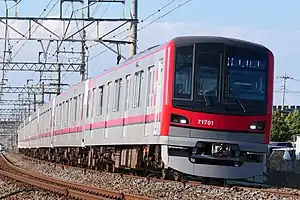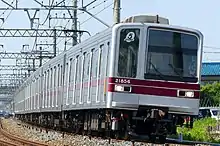| Tokyo Metro Hibiya Line | |
|---|---|
 | |
 A Hibiya Line 13000 series train in 2019 | |
| Overview | |
| Other name(s) | H |
| Native name | 東京メトロ日比谷線 |
| Owner | |
| Line number | 2 |
| Locale | Tokyo |
| Termini | |
| Stations | 22 |
| Color on map | Silver (#B5B5AC) |
| Service | |
| Type | Rapid transit |
| System | Tokyo subway |
| Operator(s) | Tokyo Metro |
| Depot(s) | Senju, Takenotsuka |
| Rolling stock | Tokyo Metro 13000 series Tobu 70000 series |
| Daily ridership | 1,213,492 (2017)[1] |
| History | |
| Opened | 28 March 1961 |
| Technical | |
| Line length | 20.3 km (12.6 mi) |
| Track gauge | 1,067 mm (3 ft 6 in) |
| Minimum radius | 126.896 m (416.33 ft) |
| Electrification | 1,500 V DC (overhead line) |
| Operating speed | 80 km/h (50 mph) |
| Train protection system | New CS-ATC |
| Maximum incline | 3.9% |
The Tokyo Metro Hibiya Line (東京メトロ日比谷線, Tōkyō Metoro Hibiya-sen) is a subway line in Tokyo, Japan, owned and operated by Tokyo Metro. The line was named after the Hibiya area in Chiyoda's Yurakucho district, under which it passes. On maps, diagrams and signboards, the line is shown using the color silver, and its stations are given numbers using the letter "H".
Overview

The Hibiya Line runs between Naka-Meguro in Meguro and Kita-Senju in Adachi. The line's path is somewhat similar to that of the Ginza Line; however, the Hibiya Line was designed to serve a number of important districts, such as Ebisu, Roppongi, Tsukiji, Kayabachō and Senju, which were not on an existing line.

The Hibiya Line became the first line operated by Tokyo Metro to offer through services with a private railway, and the second Tokyo subway line overall after the Toei Asakusa Line. It is connected to the Tobu Skytree Line at Kita-Senju, and through services operate between Naka-Meguro and Tōbu-Dōbutsu-Kōen on the Tobu Skytree Line, and onward to Minami-Kurihashi on the Tobu Nikko Line.[2] Some peak-hour services terminate at Takenotsuka, Kita-Koshigaya or Kita-Kasukabe on the Tobu Skytree Line.[2] Despite its name, the through service does not stop anywhere near the Tokyo Skytree.
The line is the first subway line overall to use 1,067 mm (3 ft 6 in) narrow gauge (as previous lines used standard gauge), and all subsequent lines operated by Tokyo Metro were built to this gauge to accommodate through services. (Of all subway lines built since the Hibiya Line, only the Asakusa, Shinjuku, and Ōedo lines were not built to this gauge.)
According to the Tokyo Metropolitan Bureau of Transportation, as of June 2009 the Hibiya Line is the eighth most crowded subway line in Tokyo, running at 164%[a] capacity between Minowa and Iriya stations.[3]
On maps, diagrams and signboards, the line is shown using the color silver, and its stations are numbered with the prefix "H".
As the old trains which have mixture of three and five doors per car have been retired, platform gates are now being installed as of 14 April 2020 with unified door arrangements of four doors per car. This also reflects with the reduction of eight-car train to seven-car trainset due to the longer 20 m (65 ft 7 in) per car trainset instead of the older 18 m (59 ft 1 in) per car trainset, which resulted in 1% reduction in capacity per train.
A reserved seat limited stop liner service known as the TH Liner commenced service since 6 June 2020 and stop at selected stations along the Hibiya Line and the Tobu lines.
Station list
- All stations are located in Tokyo.
Rolling stock
- Tokyo Metro 13000 series (7-car EMUs, since 25 March 2017)[5]
- Tobu 70000 series (7-car EMUs, since 7 July 2017)[6]
- Tobu 70090 series (7-car EMUs since 20 March 2020, for TH Liner)[7]
 Tokyo Metro 13000 series
Tokyo Metro 13000 series Tobu 70000 series
Tobu 70000 series Tobu 70090 series
Tobu 70090 series
Past
- TRTA 3000 series (from 1961 until July 1994)
- Tobu 2000 series (from 1962 until 1993)
- Tokyu 7000 series (original) (from 1964 until March 1991)
- Tokyu 1000 series (from 1991 until September 2013)
- Tokyo Metro 03 series (from 1988 until March 2020)[8]
- Tobu 20000 series (8-car EMUs, 1988 until February 2020)
 TRTA 3000 series in 1988
TRTA 3000 series in 1988 Tobu 2000 series
Tobu 2000 series Tokyu 7000 series
Tokyu 7000 series Tokyu 1000 series
Tokyu 1000 series Tokyo Metro 03 series
Tokyo Metro 03 series Tobu 20000 series
Tobu 20000 series
History
The Hibiya Line was the fourth subway line built in Tokyo after the Ginza Line, Marunouchi Line, and Toei Asakusa Line.
Its basic plan was drawn up by a Ministry of Transportation committee in 1957. Called "Line 2" at the time, it was designed to connect Naka-Meguro in southwest Tokyo with Kita-Koshigaya in the northeast. The full northeastern extension of the line was never built, as the Tobu Railway upgraded to quadruple track within the same corridor to meet capacity demands.
Work began in 1959, with the original section from Minami-Senju to Naka-okachimachi Station opening in March 1961.[9] The line opened in stages: the northern section, between Kita-Senju and Ningyōchō, was operational in May 1962; the southern section, between Naka-Meguro and Kasumigaseki, opened in March 1964.[9]
The final segment, bridging Higashi-Ginza and Kasumigaseki, opened on 29 August 1964, just weeks before the opening ceremony for the 1964 Summer Olympics.[9] Through service to the Tōkyū Tōyoko Line also began operations on this date.[9] This was something of a coup for the Teito Rapid Transit Authority (the predecessor of today's Tokyo Metro), as the Toei Asakusa Line, which was also to be completed in time for the Olympics, had fallen behind schedule and remained under construction for the duration of the Games.
The Hibiya Line was one of the lines targeted in the 1995 Aum sarin gas attack.
On 8 March 2000, five people were killed and 63 were injured when a derailed Hibiya Line train was sideswiped by a second train near Naka-Meguro Station.[10]
The line, station facilities, rolling stock, and other assets were inherited by Tokyo Metro after the privatization of the Teito Rapid Transit Authority (TRTA) in 2004.[11]
16 March 2013 marked the end of through service with Tōkyū Tōyoko Line. All Hibiya Line trains now terminate Naka-Meguro Station.[12]
Notes
a. ^ Crowding levels defined by the Ministry of Land, Infrastructure, Transport and Tourism:[13][14]
- 100% — Commuters have enough personal space and are able to take a seat or stand while holding onto the straps or hand rails.
- 150% — Commuters have enough personal space to read a newspaper.
- 180% — Commuters must fold newspapers to read.
- 200% — Commuters are pressed against each other in each compartment but can still read small magazines.
- 250% — Commuters are pressed against each other, unable to move.
References
- ↑ Tokyo Metro station ridership in 2010 Train Media (sourced from Tokyo Metro) Retrieved July 23, 2018.
- 1 2 Tobu Timetable, 16 March 2013, p.177-188
- ↑ Metropolis, "Commute", June 12, 2009, p. 07. Capacity is defined as all passengers having a seat or a strap or door railing to hold on to.
- ↑ "日比谷線新駅の名称を「虎ノ門ヒルズ駅」に決定しました!" [The name for the Hibiya Line new station has been finalised to be "Toranomon Hills Station"!] (PDF). Tokyo Metro. 5 December 2018. Archived from the original (PDF) on 11 March 2022. Retrieved 25 July 2022.
- ↑ 東京メトロ13000系が本格的な営業運転を開始 [Tokyo Metro 13000 series enters full revenue service]. Japan Railfan Magazine Online (in Japanese). Japan: Koyusha Co., Ltd. 27 March 2017. Archived from the original on 27 March 2017. Retrieved 27 March 2017.
- ↑ 東武70000系が営業運転を開始 [Tobu 70000 series enters revenue service]. Japan Railfan Magazine Online (in Japanese). Japan: Koyusha Co., Ltd. 8 July 2017. Archived from the original on 9 July 2017. Retrieved 9 July 2017.
- ↑ "東武70090形が営業運転を開始" [Tobu 70090 series starts commercial operation]. Japan Railfan Magazine Online (in Japanese). Japan: Koyusha Co., Ltd. 21 March 2020. Archived from the original on 21 March 2020. Retrieved 21 March 2020.
- ↑ "東京メトロ日比谷線03系電車が引退 イベントもなく 営団地下鉄で初の新製冷房車" [Tokyo Metro Hibiya Line 03 series train retires, the first new air-conditioned car on the Teito Rapid Transit Authority]. Traffic News (in Japanese). 3 March 2020. Archived from the original on 4 March 2020. Retrieved 25 July 2022.
- 1 2 3 4 『東京地下鉄道日比谷線建設史』 ["History of construction of Tokyo Metro Hibiya Line"] (in Japanese). Japan (published 31 January 1969). 30 May 2014.
{{cite book}}: CS1 maint: location missing publisher (link) - ↑ Failure Knowledge Database 日比谷線の列車脱線衝突 Archived 2009-02-11 at the Wayback Machine Retrieved on 11 March 2009 (in Japanese)
- ↑ "「営団地下鉄」から「東京メトロ」へ" [From "Teito Rapid Transit Authority" to "Tokyo Metro"]. Tokyo Metro Online (in Japanese). 2006-07-08. Archived from the original on 16 May 2012. Retrieved 29 May 2022.
- ↑ "東急東横線・東京メトロ日比谷線の相互直通運転が終了" [Through operation between the Tokyu Toyoko Line and Tokyo Metro Hibiya Line ends]. Japan Railfan Magazine Online (in Japanese). Japan: Koyusha Co., Ltd. 16 March 2013. Archived from the original on 12 May 2021. Retrieved 25 July 2022.
- ↑ "混雑率の推移".
- ↑ Kikuchi, Daisuke (6 July 2017). "Tokyo plans new effort to ease commuter hell on rush-hour trains". The Japan Times. Archived from the original on 6 July 2017.